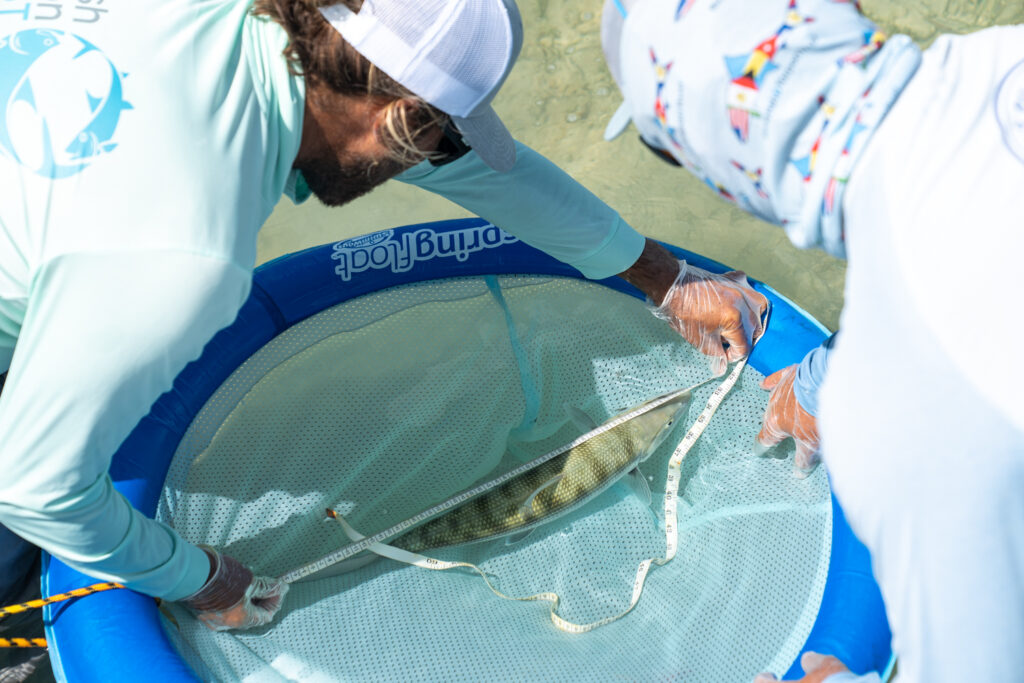Bonefish & Tarpon Trust scientists made significant progress during the 2023-24 bonefish spawning season in documenting a suspected pre-spawning aggregation (PSA) site near Key West, FL. BTT’s research in the Lower Florida Keys builds on its previous work in the Upper Keys, where BTT documented a bonefish PSA in 2023. The discovery was the first of its kind in Florida waters and a hopeful sign of a continued recovery for the species after a decades-long decline.
“Finding these nearshore areas where bonefish school by the thousands before migrating offshore to spawn in deep water is essential for their conservation,” said Jim McDuffie, BTT President and CE0. “As our science team continues to identify these sites, we will work with our state and federal partners to ensure that they are protected, ensuring a healthy future for one of Florida’s most iconic fish species.”
Over the course of the 2023-2024 bonefish spawning season, which spans from October to April, BTT Florida Keys Initiative Director Dr. Ross Boucek and his team tagged 44 bonefish with acoustic transmitters from the Marquesas to Sawyer Key with the help of Florida Keys fishing guides. BTT scientists also deployed 37 acoustic receivers on the reef tract, which allow them to monitor and record bonefish spawning movements.
“We documented seven spawning events during the 2023-2024 spawning season,” said Dr. Boucek. “Four bonefish tagged with archival depth measuring tags spawned during these events; three of the four fish recorded maximum depths of 332 feet, 310 feet, 302 feet. The fourth fish recorded a maximum depth of 180 feet on its first possible spawning or false spawning attempt. The recorded spawning depth of approximately 300 feet is consistent between the Upper Key spawning site and the suspected spawning site near Key West, and with recorded spawning events in The Bahamas.”
From its previous work in Florida and The Bahamas, BTT knows how bonefish reproduce. During full and new moon cycles from fall through early spring, bonefish migrate 70 miles or more from their home ranges to nearshore PSA sites, where they prepare to spawn by porpoising at the surface and gulping air to fill their swim bladders. At night, they swim offshore and dive hundreds of feet before surging back up to the surface. It is believed that the sudden change in pressure as they ascend makes their swim bladders expand, causing them to release their eggs and sperm. After fertilization takes place, the eggs hatch in about 24 hours, and the larvae drift in ocean currents for between 41 and 71 days before settling in shallow sand- or mud-bottom bays, where they develop into juvenile bonefish.
Meanwhile, in the Upper Keys, BTT continues to collaborate with state and federal partners to ensure that the first documented bonefish PSA is adequately protected. To this end, BTT is working to provide higher resolution spatial information of the PSA in Biscayne National Park to inform the possible expansion of a Marine Protected Area to include the spawning area.
“BTT received an infrastructure loan of $80,000 dollars to provide tracking equipment to build a fine-scale tracking array at the aggregation site,” said Dr. Boucek. “The goal is to further document the areas used by the spawning bonefish and whether they preferentially use living coral habitats.”
In Biscayne Bay, Dr. Boucek and his team deployed an array of receivers in the fall of 2023 and tagged seven bonefish. They also continue to actively track the 45 bonefish previously tagged in the area.
“Our long-term goals are to conserve the reproductive cycle of our growing bonefish in the Florida Keys,” said Dr. Boucek. “We still need to know where spawning occurs across the Keys, what threats like habitat loss those spawning fish might face, where their larvae go, and the habitats the juveniles need to ensure that our new population of bonefish can reach their full potential.”




